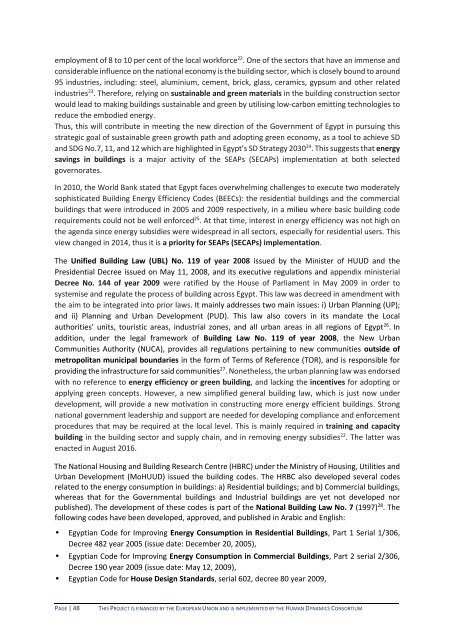180917_CES-MED_National_Report_Egypt_FINAL2rev
You also want an ePaper? Increase the reach of your titles
YUMPU automatically turns print PDFs into web optimized ePapers that Google loves.
employment of 8 to 10 per cent of the local workforce 22 . One of the sectors that have an immense and<br />
considerable influence on the national economy is the building sector, which is closely bound to around<br />
95 industries, including: steel, aluminium, cement, brick, glass, ceramics, gypsum and other related<br />
industries 23 . Therefore, relying on sustainable and green materials in the building construction sector<br />
would lead to making buildings sustainable and green by utilising low-carbon emitting technologies to<br />
reduce the embodied energy.<br />
Thus, this will contribute in meeting the new direction of the Government of <strong>Egypt</strong> in pursuing this<br />
strategic goal of sustainable green growth path and adopting green economy, as a tool to achieve SD<br />
and SDG No.7, 11, and 12 which are highlighted in <strong>Egypt</strong>’s SD Strategy 2030 24 . This suggests that energy<br />
savings in buildings is a major activity of the SEAPs (SECAPs) implementation at both selected<br />
governorates.<br />
In 2010, the World Bank stated that <strong>Egypt</strong> faces overwhelming challenges to execute two moderately<br />
sophisticated Building Energy Efficiency Codes (BEECs): the residential buildings and the commercial<br />
buildings that were introduced in 2005 and 2009 respectively, in a milieu where basic building code<br />
requirements could not be well enforced 25 . At that time, interest in energy efficiency was not high on<br />
the agenda since energy subsidies were widespread in all sectors, especially for residential users. This<br />
view changed in 2014, thus it is a priority for SEAPs (SECAPs) implementation.<br />
The Unified Building Law (UBL) No. 119 of year 2008 issued by the Minister of HUUD and the<br />
Presidential Decree issued on May 11, 2008, and its executive regulations and appendix ministerial<br />
Decree No. 144 of year 2009 were ratified by the House of Parliament in May 2009 in order to<br />
systemise and regulate the process of building across <strong>Egypt</strong>. This law was decreed in amendment with<br />
the aim to be integrated into prior laws. It mainly addresses two main issues: i) Urban Planning (UP);<br />
and ii) Planning and Urban Development (PUD). This law also covers in its mandate the Local<br />
authorities’ units, touristic areas, industrial zones, and all urban areas in all regions of <strong>Egypt</strong> 26 . In<br />
addition, under the legal framework of Building Law No. 119 of year 2008, the New Urban<br />
Communities Authority (NUCA), provides all regulations pertaining to new communities outside of<br />
metropolitan municipal boundaries in the form of Terms of Reference (TOR), and is responsible for<br />
providing the infrastructure for said communities 27 . Nonetheless, the urban planning law was endorsed<br />
with no reference to energy efficiency or green building, and lacking the incentives for adopting or<br />
applying green concepts. However, a new simplified general building law, which is just now under<br />
development, will provide a new motivation in constructing more energy efficient buildings. Strong<br />
national government leadership and support are needed for developing compliance and enforcement<br />
procedures that may be required at the local level. This is mainly required in training and capacity<br />
building in the building sector and supply chain, and in removing energy subsidies 22 . The latter was<br />
enacted in August 2016.<br />
The <strong>National</strong> Housing and Building Research Centre (HBRC) under the Ministry of Housing, Utilities and<br />
Urban Development (MoHUUD) issued the building codes. The HRBC also developed several codes<br />
related to the energy consumption in buildings: a) Residential buildings; and b) Commercial buildings,<br />
whereas that for the Governmental buildings and Industrial buildings are yet not developed nor<br />
published). The development of these codes is part of the <strong>National</strong> Building Law No. 7 (1997) 28 . The<br />
following codes have been developed, approved, and published in Arabic and English:<br />
• <strong>Egypt</strong>ian Code for Improving Energy Consumption in Residential Buildings, Part 1 Serial 1/306,<br />
Decree 482 year 2005 (issue date: December 20, 2005),<br />
• <strong>Egypt</strong>ian Code for Improving Energy Consumption in Commercial Buildings, Part 2 serial 2/306,<br />
Decree 190 year 2009 (issue date: May 12, 2009),<br />
• <strong>Egypt</strong>ian Code for House Design Standards, serial 602, decree 80 year 2009,<br />
PAGE | 48<br />
THIS PROJECT IS FINANCED BY THE EUROPEAN UNION AND IS IMPLEMENTED BY THE HUMAN DYNAMICS CONSORTIUM

















